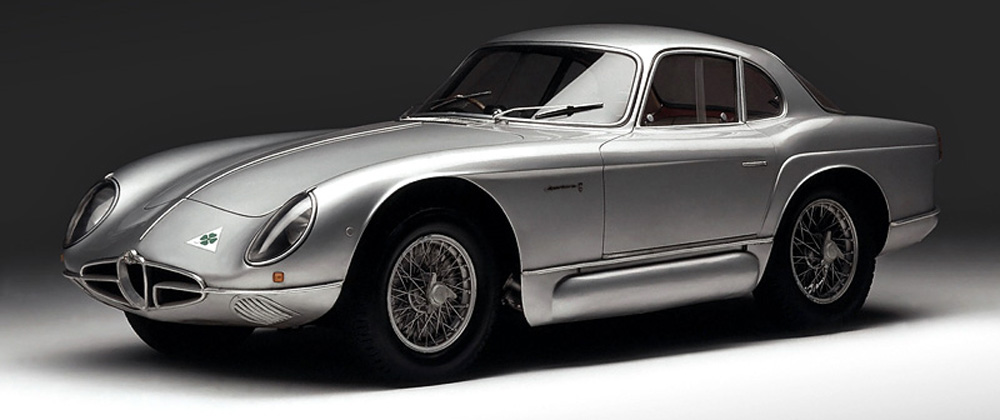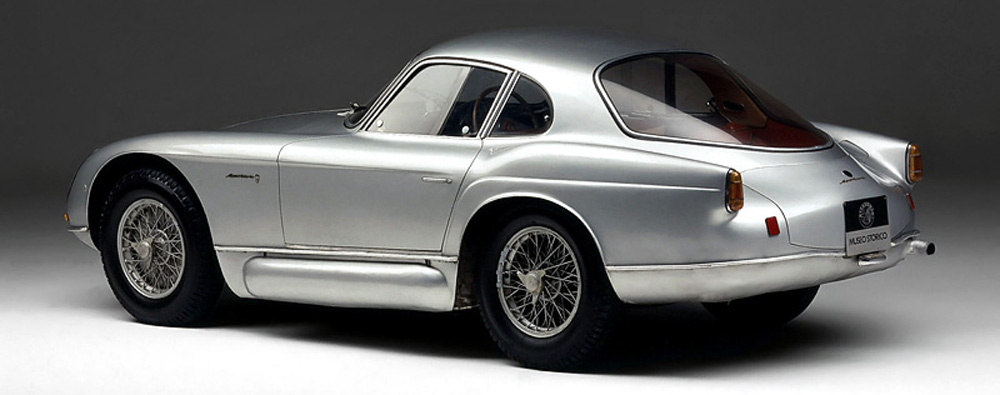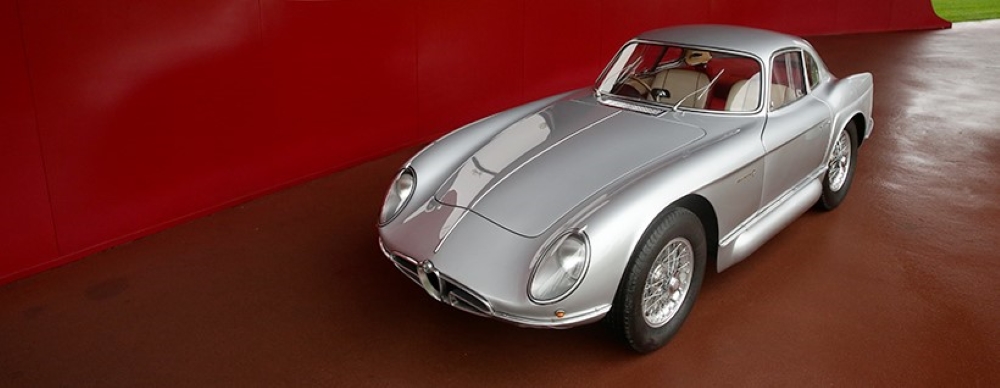
2000 Sportiva (1954)
Engine:………. in-line 4, 1997 cc, twin cam
Power:………..138 hp @ 6500 rpm (136 bhp)
Top speed:…..138 mph (220 kmph)
Body:………….Bertone
The 1954 “2000 Sportiva” is one of the most finest example of Italian design (by Franco Scaglione, signed as “Bertone” on the body): it’s a “gran turismo” based on “1900” engine, 5 speed gearbox, “De Dion” rear suspension. This technical solution anticipated the 1972 “Alfetta”.

In 1954 Bertone created two prototypes for Alfa Romeo, a spider and a coupé, supplementing the race-winning 1900 series with the aim of extending Alfa Romeo’s competitive dominance beyond the Touring class. Despite not entering mass production, the two cars marked a key milestone in the Milanese automaker’s stylistic evolution: in particular, the lines of the 2000 Sportiva inspired the shape of the iconic Giulietta Sprint.
1950 was a breakthrough year in the history of Alfa Romeo’s industrial transformation, because in that year the new 1900 saloon became the brand’s first car produced on an assembly line, at the Portello plant. Alfa not only stepped up a gear, riding on the wave of Italy’s post-war economic revival, but the restructuring of its manufacturing systems radically changed the company’s internal organisation.
Alfa concentrated all its economic and human resources on the large-scale production of the “Millenove”, eventually turning its back on the Formula 1 World Championship after having won it twice in a row. However, Alfa Romeo’s commitment to racing did not end there, on the contrary: the 1900 itself soon became “the family car that wins races”. Buoyed by Alfa Romeo’s victories in the Touring class, the company management commissioned several Italian coachbuilders to develop racing cars modelled on the new saloon, for homologation in the GT and Sport classes.
In 1952, Milanese coachbuilder Touring created the futuristic Alfa Romeo 1900 C52, commonly known as the “Disco Volante” (Italian for “Flying Saucer”), which resembled a spaceship with its outlandish contours, wide front wings and low-slung body.
In 1954, Turin-based coachbuilder Bertone was also tasked with developing two prototypes, a spider and a coupé—which became the Alfa Romeo 1900 Sport Spider and the 2000 Sportiva—with a view to producing a limited run of 100 units.
At the heart of both cars was the twin-cam engine of the 1900 with an increased bore which, thanks to the larger cylinder diameter, boosted the displacement right to the limit of the 2000cc class. The 1997cc engine developed 136 HP at 6500 rpm, powered by two large double-barrel carburettors that accompanied the unmistakable cylinder head with twin camshaft. The engine was also equipped with a sophisticated dry sump lubrication system, specifically for competitive use.
The 2000 Sportiva featured a refined tubular steel spaceframe dressed in a light aluminium alloy body, but had the same technical setup as the 1900 production car: longitudinally mounted front engine and rear wheel drive. The independent front suspension was paired with a sophisticated De Dion rear axle with a Watt’s parallelogram linkage, with the drum brakes located at the differential output shaft, instead of near the wheel hubs.
Although they shared identical mechanicals, the spider and coupé were very different in appearance.

Particularly at the rear of the coupé, the aerodynamic lines of the 2000 Sportiva altered the proportions of the rear window, fenders, boot lid and lights. These elements would go on to play an important role in Alfa Romeo’s future successes.
Franco Scaglione was the designer behind these contrasting car bodies: the coupé version was nicknamed the “Sportiva”. The aerodynamics were carefully crafted, starting with the low oval grille with characteristic stylised Alfa Romeo shield at its centre. It was bordered by a thin chrome strip that continued over the front bumper and along the sides of the car. On the underside of the strongly tapered nose, two slotted intakes directed cooling air to the front drum brakes. A central rib descended over the low bonnet to the radiator grille, flanked by plexiglass headlight covers that complemented the aerodynamic profile of the two front wings.
The two-seater passenger compartment was brightly illuminated, with a steeply sloped front windshield and sliding plexiglass side windows. The large, rounded rear windshield dominated the entire back end, supported on the sides by two fin-shaped fenders, which housed the rear lights and accentuated the curved contour that started from the back of the doors.
The thin chrome strip started at the front bumper and continued under the doors to the rear wings and back end, where it dipped slightly and was interrupted by the licence plate light. The word “Sportiva” appears in italic on the boot lid, under the round Alfa Romeo emblem, and on the sides accompanied by the Bertone logo.
In all, Bertone made four 2000 variants, two spiders and two coupés which, despite their excellent performance, were the only ones ever produced. Nevertheless, Franco’s Scaglione design talents once again left a lasting mark. In particular, the rear end of the 2000 Sportiva had an immediate influence on the very elegant Alfa Romeo Giulietta Sprint, which left the Bertone workshops that same year, ahead of the saloon version, and was an instant success.
Two of the cars are preserved in the Alfa Romeo History Museum in Arese: a coupé in elegant metallic silver livery and a red Alfa Romeo 1900 Sport Spider. Both are in perfect condition and frequently feature in special events such as the 1000 Miglia, where these virtually unique specimens are entered in the special class reserved for cars of priceless collectible value.
The second 2000 Sportiva coupé is still perfectly preserved and in working order. It is no longer owned by Alfa Romeo, but actively contributed to the creation of the Arese Museum’s current collection. It was sold to a collector for a noble cause in the seventies, as part of an exchange deal that saw the museum acquire one of the first Alfa Romeo cars ever produced: a 20-30 HP.




You must be logged in to post a comment.